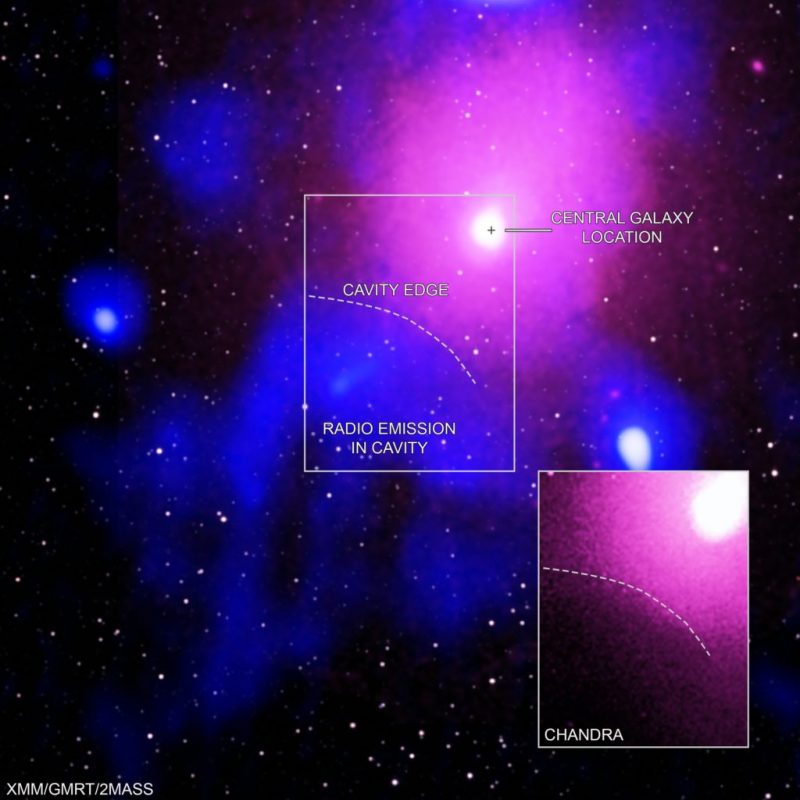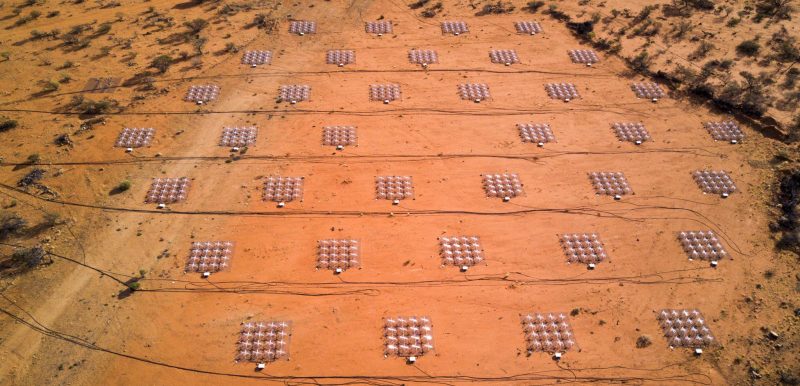
Scientists studying a distant galaxy cluster have discovered the biggest explosion seen in the universe since the Big Bang. The blast came from a supermassive black hole at the center of a galaxy hundreds of millions of light-years away. The blast released five times more energy than the previous record holder.
Curtin University astrophysicist Melanie Johnston-Hollitt is a co-author of a study about the new discovery, published in The Astrophysical Journal on February 28, 2020. She said the event was extraordinarily energetic:
We’ve seen outbursts in the centers of galaxies before but this one is really, really massive. And we don’t know why it’s so big. But it happened very slowly, like an explosion in slow motion that took place over hundreds of millions of years.
The gargantuan explosion occurred in the Ophiuchus galaxy cluster, about 390 million light-years from Earth. Galaxy clusters are the largest structures in the universe held together by gravity, containing thousands of individual galaxies, dark matter, and hot gas. In the center of the Ophiuchus cluster, there is a large galaxy that contains a supermassive black hole. Researchers think that the source of the gigantic eruption is this black hole. The explosion was so powerful, it punched a cavity in the cluster plasma, the super-hot gas surrounding the black hole.
Although black holes are famous for pulling material toward them, they often expel prodigious amounts of material and energy. This happens when matter falling toward the black hole is redirected into jets, or beams, that blast outward into space and slam into any surrounding material.
Astronomers say the amount of energy required to create the cavity in Ophiuchus is about five times greater than the previous record holder, MS 0735+74, and hundreds and thousands of times greater than typical clusters.

Evidence for the biggest explosion seen in the universe comes from a combination of X-ray data from Chandra and XMM-Newton, and the Murchison Widefield Array and Giant Metrewave Telescope, as shown here. The eruption is generated by a black hole located in the cluster’s central galaxy, which has blasted out jets and carved a large cavity in the surrounding hot gas. Researchers estimate this explosion released five times more energy than the previous record holder and hundreds of thousands of times more than a typical galaxy cluster. Read more about this image. Image via NASA.
Study lead author Simona Giacintucci, of the Naval Research Laboratory in Washington DC, said the blast was similar to the 1980 eruption of Mount St. Helens, which ripped the top off the mountain. She said in a statement:
The difference is that you could fit 15 Milky Way galaxies in a row into the crater this eruption punched into the cluster’s hot gas.
Astronomers made this discovery using X-ray data from NASA’s Chandra X-ray Observatory and ESA’s XMM-Newton, and radio data from the Murchison Widefield Array (MWA) in Australia and the Giant Metrewave Radio Telescope (GMRT) in India.
Johnston-Hollitt said the cavity in the cluster plasma had been seen previously with X-ray telescopes, but scientists initially dismissed the idea that it could have been caused by an energetic outburst, because it would have been too big. She said:
People were skeptical because the size of outburst. But it really is that. The universe is a weird place.
The researchers only realized what they had discovered when they looked at the Ophiuchus galaxy cluster with radio telescopes. Maxim Markevitch, from NASA’s Goddard Space Flight Center. is a study co-author. He said:
The radio data fit inside the X-rays like a hand in a glove This is the clincher that tells us an eruption of unprecedented size occurred here.
Read more about the discovery here.

The Murchison Widefield Array (MWA) is a low frequency radio telescope in Australia. Image via ICRAR.
Bottom line: Astronomers studying a distant galaxy cluster have discovered the biggest explosion seen in the universe since the Big Bang.
Source: Discovery of a giant radio fossil in the Ophiuchus galaxy cluster
Via International Centre for Radio Astronomy Research
from EarthSky https://ift.tt/2VAVb4A

Scientists studying a distant galaxy cluster have discovered the biggest explosion seen in the universe since the Big Bang. The blast came from a supermassive black hole at the center of a galaxy hundreds of millions of light-years away. The blast released five times more energy than the previous record holder.
Curtin University astrophysicist Melanie Johnston-Hollitt is a co-author of a study about the new discovery, published in The Astrophysical Journal on February 28, 2020. She said the event was extraordinarily energetic:
We’ve seen outbursts in the centers of galaxies before but this one is really, really massive. And we don’t know why it’s so big. But it happened very slowly, like an explosion in slow motion that took place over hundreds of millions of years.
The gargantuan explosion occurred in the Ophiuchus galaxy cluster, about 390 million light-years from Earth. Galaxy clusters are the largest structures in the universe held together by gravity, containing thousands of individual galaxies, dark matter, and hot gas. In the center of the Ophiuchus cluster, there is a large galaxy that contains a supermassive black hole. Researchers think that the source of the gigantic eruption is this black hole. The explosion was so powerful, it punched a cavity in the cluster plasma, the super-hot gas surrounding the black hole.
Although black holes are famous for pulling material toward them, they often expel prodigious amounts of material and energy. This happens when matter falling toward the black hole is redirected into jets, or beams, that blast outward into space and slam into any surrounding material.
Astronomers say the amount of energy required to create the cavity in Ophiuchus is about five times greater than the previous record holder, MS 0735+74, and hundreds and thousands of times greater than typical clusters.

Evidence for the biggest explosion seen in the universe comes from a combination of X-ray data from Chandra and XMM-Newton, and the Murchison Widefield Array and Giant Metrewave Telescope, as shown here. The eruption is generated by a black hole located in the cluster’s central galaxy, which has blasted out jets and carved a large cavity in the surrounding hot gas. Researchers estimate this explosion released five times more energy than the previous record holder and hundreds of thousands of times more than a typical galaxy cluster. Read more about this image. Image via NASA.
Study lead author Simona Giacintucci, of the Naval Research Laboratory in Washington DC, said the blast was similar to the 1980 eruption of Mount St. Helens, which ripped the top off the mountain. She said in a statement:
The difference is that you could fit 15 Milky Way galaxies in a row into the crater this eruption punched into the cluster’s hot gas.
Astronomers made this discovery using X-ray data from NASA’s Chandra X-ray Observatory and ESA’s XMM-Newton, and radio data from the Murchison Widefield Array (MWA) in Australia and the Giant Metrewave Radio Telescope (GMRT) in India.
Johnston-Hollitt said the cavity in the cluster plasma had been seen previously with X-ray telescopes, but scientists initially dismissed the idea that it could have been caused by an energetic outburst, because it would have been too big. She said:
People were skeptical because the size of outburst. But it really is that. The universe is a weird place.
The researchers only realized what they had discovered when they looked at the Ophiuchus galaxy cluster with radio telescopes. Maxim Markevitch, from NASA’s Goddard Space Flight Center. is a study co-author. He said:
The radio data fit inside the X-rays like a hand in a glove This is the clincher that tells us an eruption of unprecedented size occurred here.
Read more about the discovery here.

The Murchison Widefield Array (MWA) is a low frequency radio telescope in Australia. Image via ICRAR.
Bottom line: Astronomers studying a distant galaxy cluster have discovered the biggest explosion seen in the universe since the Big Bang.
Source: Discovery of a giant radio fossil in the Ophiuchus galaxy cluster
Via International Centre for Radio Astronomy Research
from EarthSky https://ift.tt/2VAVb4A

Aucun commentaire:
Enregistrer un commentaire